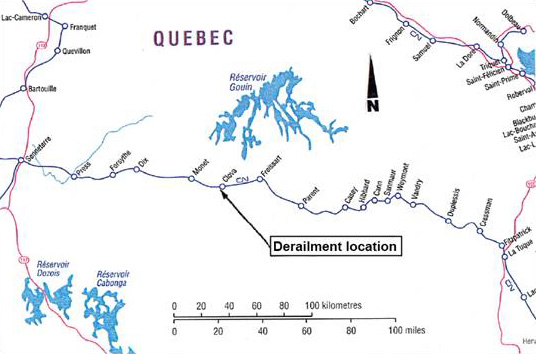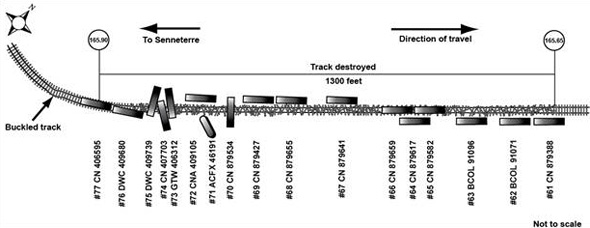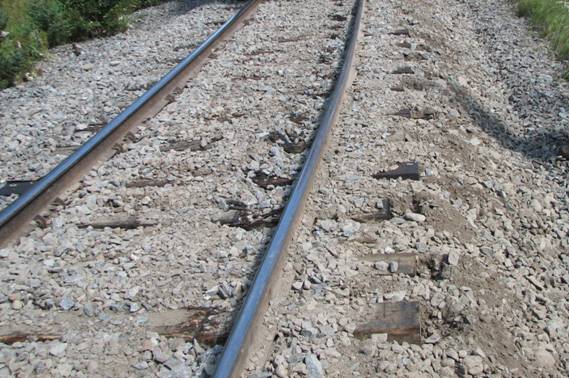Main-track derailment
Canadian National
Freight train M-365-21-23
Mile 165.80, Saint-Maurice Subdivision
Clova, Quebec
The Transportation Safety Board of Canada (TSB) investigated this occurrence for the purpose of advancing transportation safety. It is not the function of the Board to assign fault or determine civil or criminal liability. This report is not created for use in the context of legal, disciplinary or other proceedings. See Ownership and use of content. Masculine pronouns and position titles may be used to signify all genders to comply with the Canadian Transportation Accident Investigation and Safety Board Act (S.C. 1989, c. 3).
Summary
On 23 August 2010, at 1630 Eastern Daylight Time, 17 cars (16 loads and 1 empty) from Canadian National train M-365-21-23 derailed at Mile 165.80 of the Saint-Maurice Subdivision, near Clova, Quebec. Approximately 1300 feet of track was destroyed. There were no injuries and no permanent damage to the environment.
Ce rapport est également disponible en français.
Factual information
On 23 August 2010, Canadian National (CN) freight train M-365-21-23 (the train) departed Senneterre, Quebec and proceeded eastward, destined for La Tuque, Quebec. The train was made up of 5 locomotives, 2 of which were isolated, and 95 cars (90 loads and 5 empties); it weighed approximately 13 100 tons and was about 5640 feet long. The crew consisted of a locomotive engineer and a conductor. They knew the area well, were qualified for their respective positions, and met fitness and rest standards. The sky was clear and the temperature was 21°C.
At approximately 1630,Footnote 1 while approaching the town of Clova (see Figure 1) at a speed of 38 mph, a train-initiated emergency brake application occurred when the locomotive was at Mile 164.97. The lead locomotive came to rest at Mile 164.70. Seventeen cars (the 61st to the 77th) had derailed.
Site examination
The derailment zone covers a distance of approximately 1300 feet (see Figure 2). The derailed equipment consisted of 10 gondola cars loaded with wood chips, 1 empty covered hopper car (residue of sodium cyanide UN1689), and 6 covered cars carrying newsprint.
The first 4 derailed cars, the 61st to the 64th, were tipped on their side on the south side of the track. The next 2 cars (cars 65 and 66) came to rest upright on their trucks in the centre of the platform. Cars 67, 68 and 69 were tipped on their side on the north side of the track. The next cars, the 70th to the 75th, were piled up near the derailment point. The last 2 derailed cars remained upright on the track, the 76th with both trucks derailed and the 77th with only the leading truck derailed.
All of the derailed equipment was examined; no pre-derailment defects were found. The train had undergone a detailed inspection and a pull-by inspection when departing Senneterre and no faults were reported. The train later went past the hot box detector at Mile 214.8 without tripping an alarm.
To the west of the derailment zone, the track makes a 4 degree 45 minute left-hand curve in the direction of travel for a distance of 2014 feet. East of the derailment point at Mile 165.80, the track crosses a marshy area and has a straight section ending at Mile 165.63, where it curves to the right 2 degrees 0 minutes over a distance of 773 feet.
The curved section of track west of the derailment point consisted of 115-pound continuous welded rail (CWR), and the straight section to the east of the derailment point consisted of 100-pound rail. The rails were laid on double-shouldered tie plates fastened to the ties with 3 spikes. There were about 3200 hardwood ties per mile of track with rail anchors every second tie.
In the eastern part of the curve, about 75 feet behind the last derailed car, the track had shifted laterally about 12 inches toward the outside of the curve (south side of the track). The ballast consisted mainly of crushed rock, was in good condition and showed no signs of fouling. The ballast was disturbed and the shoulder was only about 6 inches wide (see Photo 1). Over 50% of the ties had been replaced recently.
In the buckled area, which was about 50 feet long, a diagonal wheel flange mark was observed on the north rail head starting at the gauge line. Five feet from that mark, the ties and tie plates showed impact marks on the field side. Corresponding marks were observed on the ties on the gauge side of the south rail. These marks extended to the derailed cars.
Track information
Saint-Maurice Subdivision consists of a single main track running from Fitzpatrick Yard near La Tuque (Mile 0.0) to Senneterre (Mile 257.52). Train movements are governed by the Occupancy Control System authorized under the Canadian Rail Operating Rules and supervised by a rail traffic controller in Montreal, Quebec. The track is Class 3 as defined in the Track Safety Regulations (TSR) and approved by Transport Canada. In the area of the accident, the maximum authorized speed is 35 mph for freight trains and 40 mph for passenger trains. Rail traffic consists of 2 freight trains and 1 passenger train per day, with an annual tonnage of approximately 3.6 million gross tons.
The track was inspected regularly and no defects were reported in the area of the derailment. The last visual inspection of the track was on Friday 20 August 2010, the last run with the track geometry test car was on 11 June 2010, and the last rail defect check was on 20 August 2010.
Recorder information
The event recorder indicated that, at the time of the accident, the train was travelling at 38 mph with the throttle in position 4, the dynamic brake was not applied and the air brakes were released.
Track maintenance
Between 16 and 21 August 2010, a tie gang replaced ties and levelled the track from Mile 162.84 to Mile 172.50. The gang worked at night, starting at 2000 and finishing at 0400. On 20 August 2010, the gang began working on the section from Mile 166.60 to Mile 165.70. The minimum outdoor temperature was 8°C. The tie gang replaced about 1820 ties, including some in the curve where the derailment occurred. The track was levelled and compacted with a dynamic stabilizer. When work ended, between 0300 and 0400, an inspector did a visual check of the work from a hi-rail vehicle and no deficiencies were noted. No slow order was placed on the track from Mile 164.0 to Mile 169.0 for the period from 16 August 2010 to 23 August 2010; nor was it required by the CN Engineering Track Standards dated March 2007 and the Track Standards Bulletin dated 22 May 2009 on temporary speed limits for disturbed track.
Rail-neutral temperature
In the Saint-Maurice Subdivision, the existing rails near Clova were installed in the early 1970s. In those days, the preferred rail-laying temperature (PRLT) was 21.1°C (70°F). In 2010, the PRLT in effect was 32.2°C (90°F). Newly laid rails that are installed at a temperature outside the PRLT range must be destressed as soon as possible after laying, but this is not mandatory for rails laid in the past.
At the time of installation, the rail is free of any tensile or compressive stresses. It is at the rail-neutral temperature. However, whenever the rail temperature exceeds the neutral temperature, longitudinal compressive forces develop. Extremely high or low ambient air temperatures, mechanized track maintenance activities (e.g., tie replacement and track levelling programs), and traffic-induced movements of the rail can cause a change or redistribution of the rail's internal stresses, thus modifying the neutral temperature. In general, the rail-neutral temperature decreases over time.
Risk of track buckling
The risk of a track buckling increases with the accumulated longitudinal compression stresses in the rail or when the lateral resistance of the track structure diminishes. Most instances of track buckling occur in a curve. They are more likely to occur when at least one of these factors is present:
- high thermal compression stresses in the rail;
- weakened track structure;
- forces applied by a passing train; and
- poor track geometry.
A report entitled Effects of Maintenance Operations on Track Buckling PotentialFootnote 2 states that track maintenance such as tie renewal or surfacing can "typically result in a 40% to 60% loss of lateral resistance". A dynamic stabilizer will "restore up to 60% to 80% of the original resistance, which is considered by most railways to provide adequate restraint against track buckling under most conditions". The report also shows that, after an additional 6 to 10 million gross tons of traffic, the track still has not fully regained its pre-maintenance lateral resistance.
Night shift and diminished vigilance
Almost all body functions (e.g., internal temperature, digestion, hormone level) are governed by a daily cycle known as circadian rhythm. The most significant effect of the circadian rhythm is that we are programmed to be awake during the day and asleep at night. When the circadian rhythm is disrupted, our performance and cognitive function can decrease. Night-shift workers are particularly affected by these altered functions. Performance and cognitive function are lowest during periods when the circadian rhythm dictates that we should sleep. Precise measurements of performance, particularly reaction times and alertness to train safety, show that performance is at its lowest during the night shift.
Humans experience 2 periods of maximum drowsiness in every 24-hour period. The times can vary from one person to another, but the principal drowsiness period generally occurs between 0300 and 0500, and the secondary drowsiness period is between 1500 and 1700. Irrespective of motivation and circumstances, a person may have a hard time remaining vigilant during the periods of maximum drowsiness.
Analysis
Although the train was travelling approximately 3 mph above the permissible speed, it is unlikely that the overspeed contributed to the accident. As the operation of the train otherwise met all company and regulatory requirements, and no defective equipment was identified, it is considered that neither the manner of train operation nor the equipment condition played a role in this accident. The analysis will therefore focus on the maintenance work and the lateral deviation of the track.
The accident
As the locomotives and the first 60 ballasted cars passed over the east end of the curve, the track shifted gradually out of alignment. Lateral forces exerted by the car wheels as they rolled by caused slight deviations in the rail. The deviations became worse with each passing car until the track suddenly shifted. The next cars, loaded with wood chips, failed to negotiate the buckled track and derailed.
The lateral shift of about 12 inches observed at the east end of the curve, about 75 feet behind the last derailed car, suggests a buckled track. The buckling of the track in a curve is consistent with the circumstances of similar failures due to buckling. Similarly, the failure occurring while the train was rolling past and causing the last cars of the train to derail is typical of accidents due to a buckled track.
Compression stress in the rail increases when the rail-neutral temperature is different from the ambient temperature. When the work was done on 20 August 2010, the track was disturbed while the ambient temperature was 8°C; consequently, the stresses in the rail were redistributed, causing a further decrease in the rail-neutral temperature in the derailment area. On the day of the derailment, the ambient temperature was at its highest point since the work, thereby increasing the thermal stresses in the rail. Since the rail-neutral temperature in the derailment area was lowered due to the work, the track became more susceptible to buckling.
Capacity to resist lateral loads
A properly designed and maintained track will withstand the compressive stresses that normally build up within CWR. Rail anchors, rail fasteners, tie plates, ties and ballast contribute to keeping the rail from moving longitudinally and laterally. However, when the track structure has been disturbed by track maintenance activities, its lateral strength and its ability to resist buckling are diminished. Track levelling, replacement of over half of the ties at the eastern end of the curve and the narrow south shoulder weakened the track structure and decreased its capacity to resist the lateral loads generated by the cars.
Lowered Rail-Neutral Temperature
When the rails were laid in the 1970s, the PRLT, and consequently the rail-neutral temperature, were much lower than those in effect today. Since the rail-neutral temperature decreases over time, it is likely that by the time the work was begun, the rail-neutral temperature in the work area had decreased to a point below the initial laying temperature. Consequently, such areas become susceptible to buckling and present a greater risk of derailment.
Effect of dynamic stabilizer
The track maintenance work was done according to existing CN standards. The fact that the dynamic stabilizer was used and that 3 trains had passed over the work area should have provided enough lateral strength for the track to resist buckling, even though this would not fully restore its previous strength. However, since the rail-neutral temperature was exceptionally low and the track shoulder was only 6 inches wide, the restored lateral resistance – while adequate in most circumstances – was not sufficient to withstand the buckling forces generated by thermal stresses and the dynamic loads created by train M-365-21-23, the heaviest and longest to pass since the work was done.
Quality control
The visual quality control was carried out after the completion of the work. During this task, the narrow shoulder was not noticed by the inspector. Visual inspection may be adequate for identifying major deficiencies; however, this type of inspection may not be adequate for assessing specific details that are difficult to spot from a hi-rail vehicle and in the dark. The limits of a person's capability to process information have been well analyzed by several researchers in the field of cognitive psychology, including G. Miller (1956), D. Lane (1982) and C. Wickens (1984).
When performing quality control, an inspector must verify a large number of individual tasks simultaneously (e.g., track geometry profile, rail, tie plates, spikes, ties, ballast). When more than one task is performed at the same time, performance in at least one of the tasks will diminish. People can monitor 5 to 9 information elements at the same time. However, if several concurrent tasks require the use of the same faculty (e.g., vision to inspect the various work items), the number of information elements that can be processed concurrently decreases. Moreover, in this occurrence, the inspection was performed at the end of the work period during the primary period of drowsiness, when vigilance is at its lowest point.
Any one of the factors mentioned above (i.e., concurrent tasks, darkness, decreased vigilance) alone can reduce the ability of an inspector to perform the required duties. The situation is worsened when more than one of these factors are present, reducing the inspector's ability to perform his work.
Findings
Findings as to causes and contributing factors
- The derailment occurred when the track shifted laterally as the train was passing.
- Since the rail-neutral temperature in the derailment area was lowered due to the work, the track became more susceptible to buckling.
- Track levelling, tie replacement and the narrow shoulder, which was not detected during the quality control performed at the end of the work, weakened the track structure and reduced its capacity to resist lateral loads generated by the cars.
Finding as to risk
- Since the rail-neutral temperature diminishes over time, it is likely that, in some portions of the track, it diminished to the point where it was lower than the initial laying temperature. Consequently, such areas become susceptible to buckling and present a greater risk of derailment.
- Use of the dynamic stabilizer and the passage of a number of trains over the work area does not provide enough lateral strength for the track in all circumstances.
- Certain factors (e.g., concurrent tasks, darkness, reduced vigilance), whether alone or in combination, can reduce the inspector's ability to perform his work.
Safety action
On 31 August 2010, Canadian National issued new procedures concerning the action to be taken after ties are laid and the dynamic stabilizer is used. Before normal train speed is resumed following work, a 10 mph slow order must be in place for the first 2 trains and 30 mph for the next 2 trains, and the track must be inspected after the passage of each of those trains.
This report concludes the Transportation Safety Board's investigation into this occurrence. Consequently, the Board authorized the release of this report on .


